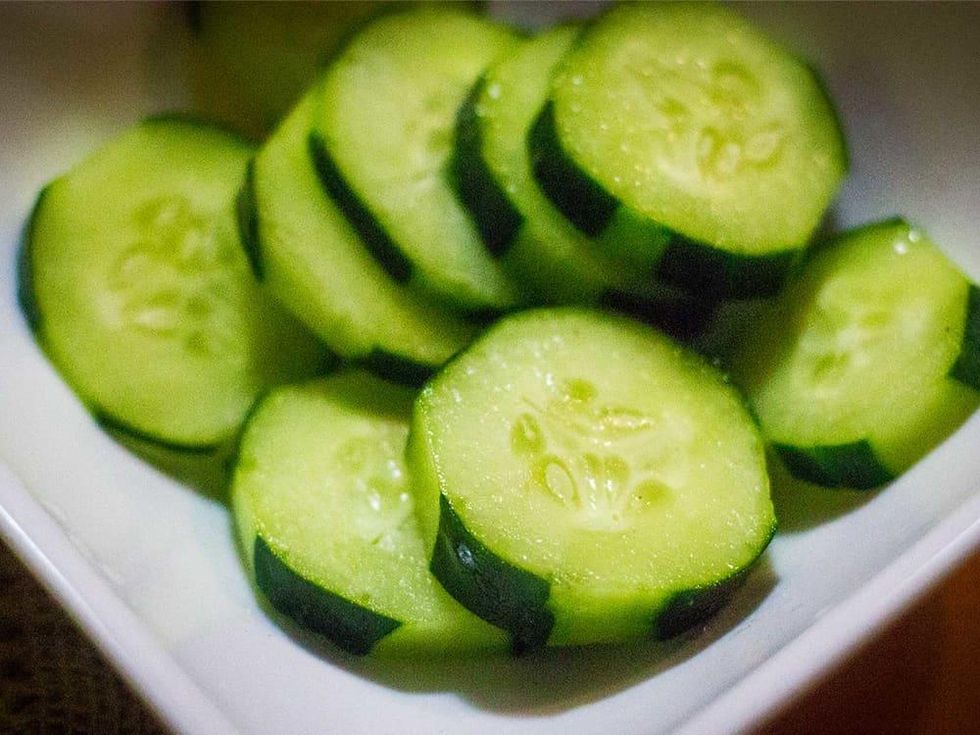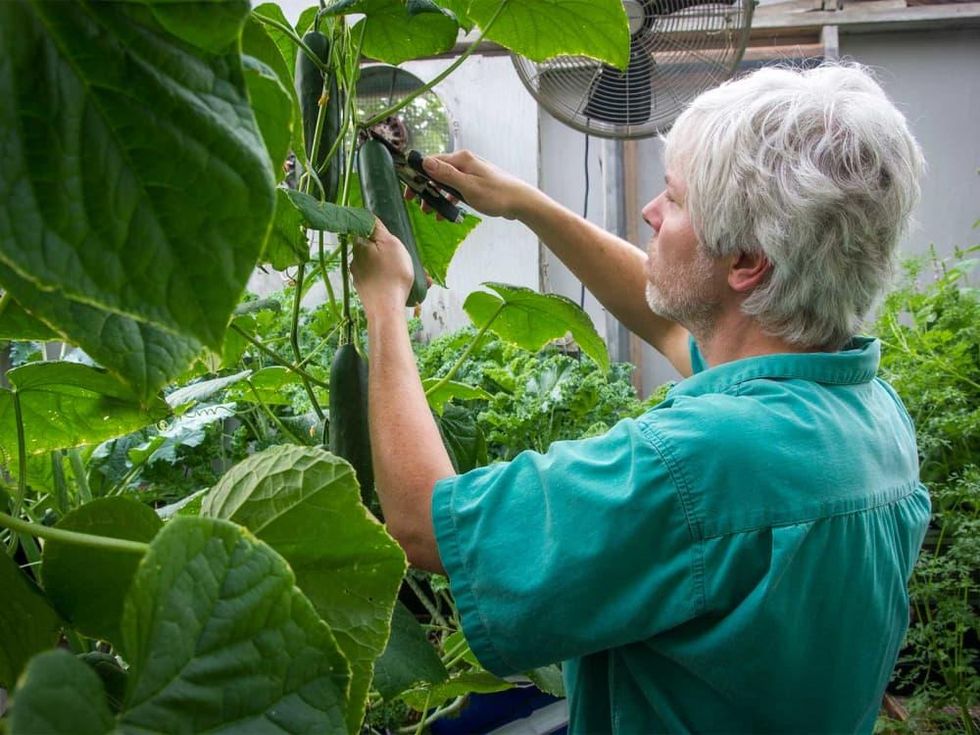The Farmer Diaries
Texas farmer shares seedless secret to growing summer veggies through winter
For years, I've grown greens right through the winter, long after cucumbers, squash, and okra have been killed by the first frost of the season. I've enjoyed the kale, collards, mustard greens, broccoli, and turnips that fill my dinner plate until the spring, even as I crave the meatier flavors of summer.
I've tried to vary my wintertime harvest. Two years ago, I grew squash and cucumbers in a small greenhouse my father built back in the '80s. But I learned that, although I could grow a pretty plant, it bore no fruit. These crops require bees to pollinate them, and there were none to be found during the cold, rainy part of the year.
I did net a few cucumbers, the result of my hand-pollination of female flowers by poking their male counterparts into their petals. But the process was time-consuming and relied on the right humidity, temperature, time of day, and age of the flower to fall into place. Mimicking nature's processes proved to be no easy task and hardly worth the effort.
The benefits of seedless hybrids
But then last fall, I stumbled onto the secret that professional growers use to grow summertime crops year-round: seedless hybrids, bred to need no insects for pollination. These are the source for the cucumbers and zucchini we see in grocery stores during the winter.
These seedless hybrids are gynoecious, which means that they produce only female flowers. Female flowers have what look like tiny fruits already formed underneath them. In fact, that's kind of what they are — but to grow into something worth eating in standard varieties, these little fruits must contain fertilized seeds or they'll dry up and fall off. Not so with the hybrids.
These hybrids have another trait that's been bred into them by trial and error: They're parthenocarpic, which means that their ovules don't need to be pollinated in order for the plant to grow a cucumber or squash large enough to pick. They grow on their own, and because they've not been pollinated, they are almost always seedless.
I was resistant to buying hybrid seed. They're not genetically engineered; hybrids have been around for centuries and are produced through traditional breeding methods. I avoid them only because they don't produce seed that can be relied on to grow a new generation of crops, which is really no big deal. So, I dropped my hang-ups and made an allowance for these hybrids because the promise of picking summer vegetables in the dead of winter was too enticing to pass up.
The trial with squash and cucumber
For my first attempt at so-called controlled environment agriculture, I bought a pack each of Partenon squash and Corinto cucumbers from Johnny's Select Seed. The seeds are pricier than standard varieties. A mini pack costs about $5 or $6 for just 10 seeds, which is understandable because hybrids are labor intensive and can take decades of breeding to perfect.
A mishap involving crickets left me with only three squash sprouts, a day or two after they popped up last January. In two-gallon plastic flower pots with coconut coir and perlite as the growing medium, they grew quickly into full-sized squash plants with broad, beautiful, green leaves and healthy stalks.
By February, they bloomed with succulent flowers that blossomed longer than the standard varieties I've grown. They didn't drop off when the fruit began to put on mass, so I was able to pluck them off whole for an added treat of fried squash blossoms.
About a week and a half after forming, the zucchini squash were ready to pick. In the kitchen, they sliced up nicely but were firmer than their standard cousins. Sauteed with onions, they were indistinguishable from the zucchini I pick in midsummer. There on my plate in the middle of winter was a side of squash, which I considered a success.
More impressive were the seedless cucumbers I planted in one-gallon plastic pots using the same growing medium. Three weeks into their growth, I found it necessary to support their fast-growing vines up several strings of jute twine that I hooked onto the rafters of the greenhouse eight feet above ground. The vines grew up the twine and across the rafters and back down toward the ground so fast that I felt I could see their progress from hour to hour.
Along each foot of their growth, a flower that needed no bees or butterflies for pollination bloomed and dropped off, leaving a shiny, dark green cucumber in its place. After about two weeks of growth, the cucumbers were ready to slice up and put in a salad.
The squash was an acceptable substitute for the superior standard summertime varieties, but the cucumbers were better than the varieties I grow outdoors. They were long and slender with thin, smooth skin. Their flavor was mild without a hint of bitterness.
Seedless success
By the beginning of March, when one last snowfall blanketed the ground outside the greenhouse, my five indoor plants were growing three to five cucumbers each. Fruit hung down all the way up the vines and down from the rafters overhead.
By spring, aphids overtook my squash plants, but I fended them off the cucumbers with a daily application of plant wash. The cucumbers continued to produce until June, when I directed my labor back to outdoor growing. They could have lived on and yielded plenty more, but I didn't have the time to tend these monster vines.
As I prepare my greenhouse for this winter, I've begun to plan on other seedless hybrids I'll try out. They'll grow with the greens I produce hydroponically. I only need to keep the temperature above 50 for everything to stay safe.
If I had no access to a greenhouse, I'd still grow a couple of pots of each in the sunlight of a south-facing patio door, maybe with a little supplemental light from an LED grow light. I can also see these doing well on an apartment balcony, as long as they're brought in any night when frost is likely. The cukes would have to be pruned, of course. A sunroom might even be a better place than a greenhouse as the warmer temperatures are preferable.
Both the squash and the cucumbers were heavy feeders; I watered them with a stout solution of hydroponic nutrients. This gave them the moisture and the food they needed in one easy task.
When it was cold and cloudy, they needed this treatment only twice a day. By May, when the sun was shining and the days were long, I watered and fed them about five times each day. I'll automate this work with pumps and timers this year.
Seedless hybrids have opened my mind up to a whole new approach to keeping my pickings coming in year-round. For now, I plan to use these to add variety to my wintertime fare. As I hope to one day move up from being just a hobby farmer to a full-time commercial grower, I'm sure I'll rely on these hybrids for a steady harvest to take to the market.




